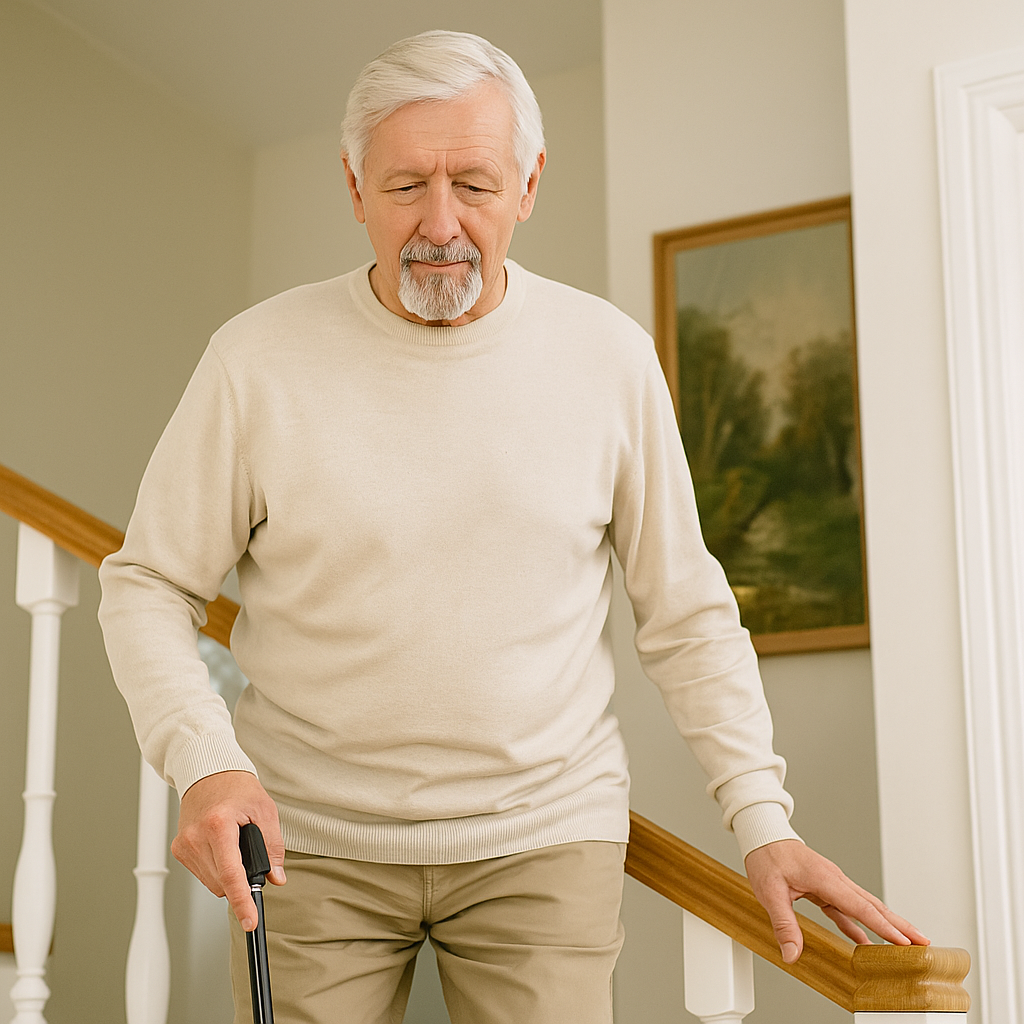Your home should make life easier — not more difficult. But as time passes, certain parts of a house can become less friendly to balance and movement.
A rug that once looked lovely can become a tripping hazard. A dim hallway can turn into a guessing game at night.
The truth is, safe movement at home doesn’t require a remodel — just thoughtful attention and a few smart upgrades.
Let’s take a walk through your home together and look for the little things that make a big difference.
Start with Awareness
Begin by slowing down. Walk through each room at your normal pace, paying attention to how you move. Do you hold onto furniture for balance? Do your feet shuffle near certain corners? That’s your body’s way of telling you where you could use extra support.
Grab a notepad and write down what you notice. This simple walk-through often reveals more than any checklist — because it’s your home and your movement patterns that matter most.
Clear Paths, Clear Mind
The safest homes are open and easy to navigate. Try these simple adjustments:
- Keep hallways and walkways at least three feet wide.
- Move clutter, shoes, and cords out of pathways.
- Remove or secure throw rugs — double-sided tape or non-slip pads help.
- Keep frequently used items at waist level to avoid bending or stretching.
🌿 A clear path is more than just tidy — it gives your mind and body a sense of ease.
Light the Way
Soft, steady light helps you feel grounded. Darkness or harsh glare can confuse your depth perception.
Here’s how to brighten safely:
- Place night lights in hallways, bedrooms, and bathrooms.
- Use motion-sensor lights for those late-night trips to the kitchen.
- Keep a lamp or flashlight within arm’s reach of your bed.
- Choose warm LED bulbs that mimic daylight without causing glare.
💡 Good lighting is one of the simplest ways to prevent a fall — and one of the most overlooked.
Safer Steps in the Bathroom
Slippery surfaces, steam, and tight spaces make bathrooms tricky.
You can change that with a few thoughtful touches:
- Install grab bars near the shower and toilet (and make sure they’re anchored, not suction).
- Add non-slip mats both inside and outside the tub.
- Use a shower chair or bench if standing for long periods feels tiring.
- Keep towels and toiletries within easy reach to avoid stretching or twisting.
🚿 A stable bathroom means less stress — and more comfort during your daily routines.
The Kitchen — Small Changes, Big Results
Cooking should feel like joy, not a balancing act.
Make your kitchen safer and easier to navigate:
- Keep heavier pots and pans on lower shelves.
- Store everyday dishes at waist level.
- Use rubber-backed rugs in front of the sink or stove.
- Clean spills immediately, even a drop of water can be risky.
- Consider a tall, sturdy stool for tasks that take time, like chopping vegetables.
🥣 A safe kitchen helps you stay independent — and enjoy the meals you love.
Steps, Stairs, and Transitions
Even if you rarely use the stairs, they deserve attention.
A fall on stairs can cause serious injuries, so these small updates matter:
- Add handrails on both sides of the staircase.
- Make sure edges of steps are marked clearly with tape or contrasting paint.
- Keep steps clear of clutter and baskets.
- Check for loose carpeting or mats.
- Improve lighting at the top and bottom — a sensor light works perfectly.
If stairs are no longer practical, talk with a family member about options such as a stair lift or first-floor bedroom setup.
Bedroom Safety
The bedroom should feel restful and safe from the moment you stand up.
- Place a lamp or light switch within reach of the bed.
- Keep a stable chair or grab bar nearby for balance when dressing.
- Choose firm mattresses that make standing easier.
- Avoid tall bed frames that require climbing up or down.
- Keep slippers or shoes with good grip at the bedside.
🛏️ Comfort and safety can coexist beautifully — your room can still feel warm and personal while being easy to move through.
Helpful Tools for Everyday Stability
You don’t need special equipment to stay safe, but a few simple tools can make life easier:
- Reacher/grabber tools for picking up items from the floor.
- Sock aids or long-handled shoehorns for dressing without bending.
- Bedside handles or poles for steady transfers in and out of bed.
- Chair risers to make sitting and standing smoother.
- Non-slip shoes or house slippers with firm support.
These items quietly support your independence — they’re small changes that add up to big peace of mind.
- EASY GRABBING: Reacher grabber to pick up items with easy, picks up coins, envelops, trash etc, easily pull the trigger,…
- FOLDABLE DESIGN: Adopt folding type design, shorten length, facilitate outdoor carry, also can collect in the cabinet,…
- ROTATING Head: The claw grabber’s head can be rotated up to 90 degrees, which allows to adjust direction horizontally…
- LIGHTWEIGHT MATERIAL: With high carrying load capacity, the reacher grabber tool is able to grab objects up to 3lbs…
- Note: This product is not for use with compression socks or compression stockings. Recommended regular sock types: ankle…
- Deluxe Socks Put On Assist Device: Helps individuals put on socks or stockings easily and independently. Ideal daily…
- Flexible Contoured Plastic Shell: Contour shaped shell is Soft and flexible, specially designed for individuals who have…
- Soft and Non-Slip Foam Handle for a comfortable grip. A Slip-Resistant Foam Pad keeps sock or stocking from slipping off…
- ✔️ 300 Lbs Heavy-duty Bed Rail – Yetulike bed side rails is made with premium steel frame which can provides maximum…
- ✔️ Adjustable Handle Rails For Full Size Bed – This bed assist rails is adjustable on handle height from 16-21.65″,…
- ✔️ Tool-Free Assembly & Protable Bed Assist Rails – Yetulike bed hand rails for seniors is super easy to use, the…
- ✔️ Non-slip Handle & Removable Storage Pouch – Yetulike bed rails for elderly adults safety designs with ergonomic…
- COMFORTABLE SLIP RESISTANT WORK SHOES FOR MEN – Our thick rubber soles have a slip resistant tread pattern for enhanced…
- COMFORT MENS WORK SHOES AND RESTAURANT OR FOOD SERVICE SNEAKERS – These comfortable sneakers with two straps are perfect…
- REMOVABLE MEMORY FOAM SOCK LINER – For pressure point relief, our MEMORYfōm responds to the unique curves of your foot…
- SUPPORTIVE & DURABLE STRAPS WALKING OR WORK SNEAKERS – The compression molded EVA midsole, anatomical heel cradle, and…
When to Ask for Help
Sometimes it helps to get another set of eyes. Occupational therapists and home safety specialists can walk through your space and suggest improvements you might overlook. Many local senior centers, insurance providers, and hospitals offer free or low-cost home safety evaluations — especially for fall prevention.
Don’t wait until you’ve had a near miss to ask. A professional visit now could save you from a serious injury later.
Moving Safely Is a Lifestyle
Safe movement at home isn’t about changing who you are — it’s about supporting how you live. It’s the small things, repeated daily, that protect your independence: steady lighting, clear floors, secure steps, and a willingness to adapt.
You’ve built a life full of habits, love, and wisdom. Your home should keep up with that — steady, secure, and always ready for you to move freely.
Recommended Reading:
- Mobility Aid Choices: Learn which devices best support your balance.
- Balance and Exercises: Gentle routines to keep you strong and steady.
- Preventing Falls and Injuries: Practical steps for everyday confidence.
Frequently Asked Questions
1. What’s the easiest way to make my home safer?
Start with small steps — remove clutter, secure loose rugs, and add better lighting in hallways and bathrooms. These changes reduce most trip and fall risks without major expense or renovation.
2. How can I move around safely at night?
Keep a night light or motion-sensor light in your bedroom, hallways, and bathroom. Place a flashlight by your bedside just in case. Bright, steady light helps your eyes adjust quickly and keeps you aware of your surroundings.
3. Are grab bars difficult to install?
Not at all. Grab bars can be installed by a handyman or family member in less than an hour. Choose bars that are securely anchored into wall studs, not suction cups — they’ll hold firm when you need them most.
4. What kind of shoes are safest to wear indoors?
Choose shoes or slippers with non-slip soles and good ankle support. Avoid loose-fitting slippers, socks without grips, or backless sandals. A secure fit keeps you stable on both carpet and hard flooring.
5. Should I use a walker or cane inside my house?
If you sometimes feel unsteady, yes — use your mobility aid indoors as well. It’s safer to use support when you need it than risk a fall when you don’t. Just make sure hallways and furniture layouts allow enough room to move comfortably.
6. Who can help me check if my home is safe?
Many local senior centers and healthcare providers offer free or low-cost home safety evaluations. An occupational therapist can walk through your home, point out risks, and suggest simple improvements tailored to your needs.









